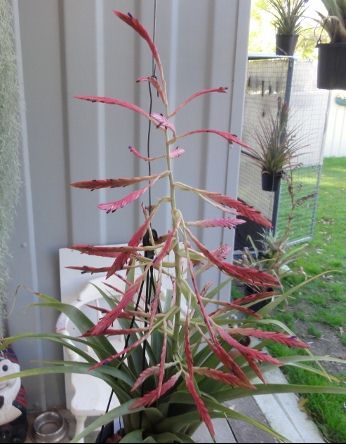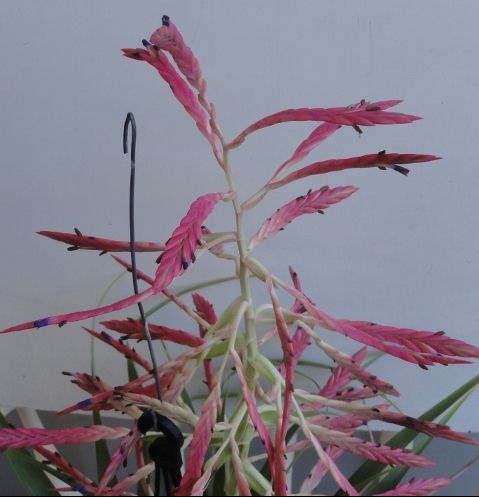




Desc from S&D p769-70
Plant stemless, flowering 2-7 dm high.
Leaves many in a crateriform rosette, 15-50 cm long, chartaceous when dry;
Sheaths elliptic, 5-12 cm long, brown, densely and finely brown-appressed-lepidote; Blades narrowly triangular, subfiliform-attenuate, 15-25 mm wide, flat, thin, even, densely and finely pale-appressed-lepidote, especially below.
Scape erect, up to 8 mm in diameter, equaling or slightly shorter than the leaves;
Scape-bracts erect, densely imbricate, foliaceous.
Inflorescence laxly compound with the lower branches simple or bearing 2-5 spikes, sub pyramidal, to 3 dm long and 2 dm in diameter; axes red, glabrous;
Primary bracts lance-ovate, their sheaths much shorter than the spreading axillary branches, but the lower ones with long foliaceous blades which usually exceed the branches;
Secondary bracts no larger than the floral bracts; spikes divergent, short-stipitate, lanceolate or linear-lanceolate, rather laxly 5-8-fiowered with several sterile bracts at base, complanate, to 7 cm long and 15 mm wide;
Rhachis slender, flexuous.
Floral bracts divergent, scarcely or not at all imbricate and completely exposing the rhachis, elliptic, obtuse when expanded, to 16 mm long, equaling or exceeding the sepals, 3 times as long as the internodes, ecarinate, chartaceous, prominently nerved, glabrous or sparsely lepidote toward apex;
Flowers short-pedicellate.
Sepals elliptic, obtuse, 11-13 mm long, coriaceous, glabrous, free;
Petals with linear claw and elliptic obtuse blade, 18 mm long;
Stamens and pistil included.
Type. Bourgeau 3076 (holotype K, GH photo), Orizaba, Vera Cruz, Mexico, 1865-66.
DISTRIBUTION. Saxicolous and epiphytic, cliffs and forest, 900-2400 m alt, central Mexico.
MEXICO. HIDALGO: Zacualtipan, 21 Apr 1891, Maury 5878 (GH); 20 Mar 1947, Moore 2375 (US); Tatipam to Yahualica, 25 Apr 1891, Maury 5957 (GH). VERA CRUZ: Acultzingo, Dec 1841, Liebmann 44 (B, C); 27 Sep 1962, Ugent & Flores 2370 (US); Orizaba, Botteri 1003 (GH); Dec 1853, F. Mueller s n (NY); Uhde 178 (B, US); Maltrata, Matuda 1191 (MICH); Cordoba to San Lorenzo, 1939, Halbinger s n (GH); Puerto del Aire, Orizaba to Tehuacan, 8 Jan 1964, Correll 28792 (LL). PUEBLA: Chapulco, Liebmann s n (C); Rio Necaxae, Huauchinango, Feb 1932, Froderstrom & Hulten 917 (S); 1074 (S); 1104 (S); Teotitlandel Caminoto Huautla, Tehuacan, 3 Aug 1961, C E Smith Jr. et al 4182 (US). OAXACA: Huantla de Jimenez, Cerro del Fraile, 2 Aug 1938, Schultes & Reko 413 (GH); km 272, Puebla to Cordoba, 1 Apr 1939, Schultes & Reko 13 (GH); Oaxaca to Lachatao, 21 Dec 1947, Mac¬Dougall s n (US).
From Baker 1889
99. T. GYMNOBOTRYA Baker in Journ. Bot. 1887, 243.
T. tridactylites E. Morren (M.D.).
Leaves 20-30, densely rosulate, ensiform-acuminate from an ovate base 1.5 in. broad, a foot long, 0.75 in. broad low down, rigidly coriaceous, finely lepidote on both surfaces. Peduncle a foot long; bract-leaves with long linear tips. Panicle lax, a foot long; spikes numerous, patent, many 3-4-nate, dense, distichous, 1-2 in. long, 0.5 in. broad; lower branch-bracts with long linear tips; flower-bracts greenish-red, oblong, 0.5 in. long. Calyx nearly as long as the bract. Petals violet, convolute in a tube, twice as long as the calyx. Stamens not longer than the petals.
Hab. Mexico; province of Orizaba, Bourgeau 3076! Panama, Wagner (Herb. Monac.). Introduced into cultivation in 1883, by M. Jacob-Makoy & Co.., of Liege.
Detail from Mez 1935
205. T. Purpusii Mez in Fedde, Repert. XIV. (1916) 251. –
Ad 0.23 m alta. Folia haud manifestius bulbose rosulata, ad 0.15 m longa, super vaginam ad 20 mm lata, inde in apicem acutissimum sensim angustata, planiuscula, e lepidibus appressis cano-virentia. Scapus erectus, foliis permulto brevior, vaginis suberectis inferioribus foliaceis superioribus plus minus vaginaceis omnino obtectus. Inflorescentia subpauciflora, 2-pinnatim panniculata, folia aequans vel paullo superans, glabra, breviter pyramidalis, pinnatim e spicis composita; bracteis primariis ex ovato acutis, non nisi infimis laminigeris, superioribus saltem ramulorum axillarium florem infimum baud attingentibus; spicis dense flabellatis, ad 8-floris, suberectis, anguste lanceolatis, utrinque acutis, ad 40 mm longis et 8 mm latis, stipitibus brevioribus sed manifestissimis, prophyllis bracteiformibus dense distiche obtectis praeditis; bracteis florigeris dense imbricatis, siccis prominulo-venosis, glabris, ne apice quidem incurvis, ad 15 mm longis, sepala bene superantibus. Flores stricte erecti, ad 18 mm longi; sepalis subaequaliter liberis, glabris, submembranaceis, ellipticis, latissime acutiusculis. Petala fulgide violacea mox brunnea, tota tubulose erecta, genitalia praeclare superantia.
Mexico: bei Boca del Monte (Purpus). Costarica: bei Tucurrique (Tonduz in Herb. inst. phys.-geogr. Costar. n. 13290). - Von Purpus lebend eingefuhrt. - Fig. 101.